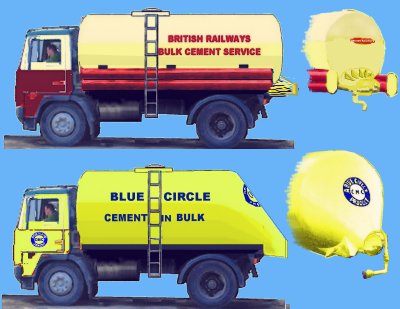Cement is quite nasty stuff so the railways were reluctant to carry it in their own wagons. There were therefore quite a number of PO cement vans, the 'Iron Mink' type van being a favourite for this traffic but there were also a number of wooden bodied types used. During the summer months, when most building work takes place, one of these PO vans parked on a siding near a building job would be a not uncommon sight, with up to half a dozen if it was a major construction in progress. If you make a hash of the livery on a PO cement van simply splash lots of white about, they were often very heavily stained with cement dust, which has a strong bleaching action. I believe the last of the iron mink cement vans were retired in the 1950's, but at about this time Blue Circle purchased some new longer wheelbase plywood bodied vans for their traffic.
There was a successful British Railways container system the `L' type container, used for cement traffic (see Fig ___). These containers were unloaded onto road vehicles in the goods yard for delivery to the site. The Graham Farish Presflo and Lima Prestwin cement wagons can serve for post 1960's bulk cement deliveries to a local station goods yard. They are not actually PO wagons although they wee often painted in cement company colours. The presflo wagons were originally designed to be unloaded into road lorries (themselves fitted with a 'pressflo' body) in goods yards for delivery to the mixing site. The unloading was accomplished using heavy, dark grey, reinforced rubber flexible hoses about four inches in diameter. Coiled-wire guitar Bottom E strings painted dark grey would serve for these hoses. The compressor used to provide the air for the system was a fairly standard type, usually a two-wheeled trailer type machine, and these can be knocked up from scrap. The sketch below shows the early BR owned lorries used for this traffic and a later PO lorry with a distinctive tapering back-end to the silo. I believe lorries of this general outline, but some much larger and running on eight wheels, continued in use into the 1970s (possibly the 1980s)
Fig ___ Cement lorries

Following the closure of the local goods yards in the late 1960's a `ready mixed concrete' plant with its own siding would be a more probable destination, taking deliveries of cement powder, sand and gravel. This option is further discussed in the section on lineside industrial premises.
Salt was shipped in PO wagons and vans of various designs. Salt has to be kept dry and up to the 1960's most was shipped in cloth bags. Most salt was shipped in vans or in comparatively high sided wagons fitted with a partial solid roof and a canvass cover over the central opening. In Cheshire quite long rakes of salt wagons would be seen but in the rest of the country one or two salt wagons in a rake would be the norm. Companies which traded in 'dry salteries' offered a number of types of salt and often other materials such as saltpetre, soda crystals and alum which might be transported in their own wagons (these companies are discussed in Volume 2 under Salt).
Tinplate is steel coated with tin, which has a better corrosion resistance, 'tin cans' are actually made of tin plated steel. To differentiate between plated steel and solid tin (one use for which is in electrical condenser coils) the latter is often called 'block tin'. Model railway multi-strand layout wire is usually called 'tinned copper wire', this is because the individual strands of copper have to be tin-plated if the wire is to be wrapped in rubber or they will corrode. The tinplate vans would have restricted workings, mainly on fixed runs between the factory (in South Wales) and either a private siding at the works using the stuff or the local goods yard for road delivery. These van featured some interesting designs some had peaked roofs and unusual side doors were common, the sketch below shows a fairly conventional type that could be easily made up using a Peco 'ventilated van' kit (the Peco van with vertically planked sides).
Fig___ Tinplate vans
